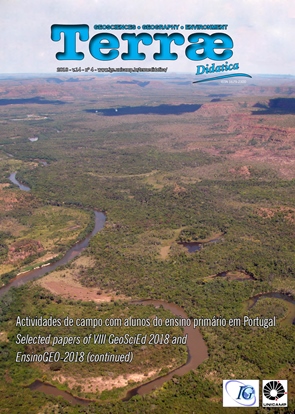Abstract
Formal methods of teaching theoretical concepts, involving the use of textbooks, still prevail in conventional teaching in Brazil. New technologies and innovations are gaining space within schools, to captivate the attention of the modern student. Through a multidisciplinary approach, and based on the connection between formal education and the real world and nature, this paper aims to disseminate, in Portuguese, a well-known proposal for a practical experiment regarding the formation of salt speleo-thems, using geological concepts related to speleology. This proposal contributes to student engagement in the natural sciences, and encourages scientific thinking by setting up and observing practical experiences that develop the scientific abilities of ob-servation and description. The experiment involves the creation a theoretical model of speleothem formation, and introduces, in an appropriate fashion, geological concepts of the formation of those rocks. This helps students to construct a conceptual framework that can be applied to several topics in the future, whether related to geology, climate or environmental sciences. The experimental approach of geoscience education produces a learning experience for students. The formation of salt speleo-thems can serve as a basis for students to begin to relate intrinsic concepts of geological science, such as time, space, and location.References
Almeida C.N., Araújo C, Mello E.F. 2015. Geologia nas Escolas de Ensino Básico: a experiência do Departamento de Geologia da Universidade Federal do Rio de Janeiro. Terrae Didatica. 11(3):150-161. URL: http://www.ige.unicamp.br/terraedidatica/. Acesso 07.09.2018.
Bernal J.P., Cruz F.W., Stríkis N.M., Wang X., Deininger M., Catunda M.C.A., Ortega-Obregón C., Cheng H., Edwards R.L., Auler A.S. 2016. High-resolution Holocene South American monsoon history recorded by a speleothem from Botuverá Cave, Brazil. Earth and Planetary Science Letters. 450(1):186–196. DOI: 10.1016/j.epsl.2016.06.008.
Carlsbad Caverns, n.d. Caves, Canyons, Cactus & Critters. A curriculum and activity guide for Carlsbad Caverns National Park. Middle School Geology. In: National Park services education. URL:https://www.nps.gov/cave/learn/education/upload/geology_middle_school.pdf. Acesso 07.09.2018.
Carneiro C.D.R., Toledo M.C.M., Almeida F.F.M. 2004. Dez motivos para a inlcusão de temas de geologia na educação básica. Rev. Bras. Geoc., 34(4):553-560. URL:http://www.ppegeo.igc.usp.br/index.php/rbg/article/viewFile/9787/9135. Acesso 07.09.2018.
Custódio, R.P., Dantas, M.A.T., Prata, A.P. do N. 2012. O uso de recursos didáticos e a Espeleologia : Reflexões sobre alternativas para ensinar Ciências e Biologia, in: VI Colóquio Internacional “Educação e Contemporaneidade”. São Cristovão, SE/Brasil. 6:1–13. ISNN:1982-3657. URL: http://educonse.com.br/viicoloquio/publicacao_eixos.asp. Acesso 07.09.2018.
Fairchild, I.J., Baker, A., 2012. Speleothem Science: From Process to Past Environments. Wiley-Blackwell. DOI: 10.1002/9781444361094. URL: https://doi.org/10.1002/9781444361094. Acesso 07.09.2018.
Ferreira R.L., Gomes F.T.M.C., Silva M.S. 2008. Uso da cartilha “Aventura da vida nas cavernas” como ferramenta de educação nas atividades de turismo em paisagens cársticas. Pesq. Tur. e Paisagens Cársticas. 1(2):145–164. URL:http://www.cavernas.org.br/ptpc/ptpc_v1_n2_145-164.pdf. Acesso 07.09.2018.
Geze B., Ribera A. 1968. La espeleología científica. Ediciones Martínez Roca. Fundación Cueva de Nerja. 2018. URL: http://www.cuevadenerja.es/en/. Acesso 11.09. 2018.
GRIC - Espeleo Grupo Rio Claro, 2011. Noções básicas de espeleologia. Apostila Didática.
Hance T., Befus K.M. 2015. Speleothems and sand castles. Sci. Child. 53(2):36–41. URL: https://s3.amazonaws.com/nstacontent/sc1502_36.pdf?AWSAccessKeyId=AKIAIMRSQAV7P6X4QIKQ&Expires=1536414798&Signature=sbE5iEnCMWo3vHUEL8PzeCxbAdQ%3d. Acesso: 07.09.2018.
Moore G.W. 1952. Speleothem: a new cave term. National Speleological Society News, 10(6):2. National Park Service, n.d. Growing Speleothems.
Stríkis N.M., Cruz, F.W., Cheng, H., Karmann, I., Edwards, R.L., Vuille, M., Wang, X., de Paula, M.S., Novello, V.F., Auler, A.S. 2011. Abrupt variations in South American monsoon rainfall during the Holocene based on a speleothem record from central-eastern Brazil. Geology 39: 1075–1078. URL: https://doi.org/10.1130/G32098.1. Acesso: 07.09.2018.
Teixeira W., Toledo M.C.M.de, Fairchild T.R., Taioli F. 2000. Decifrando a terra. São Paulo: Oficina de textos.
A Terrae Didatica utiliza a licença do Creative Commons (CC), preservando assim, a integridade dos artigos em ambiente de acesso aberto.

